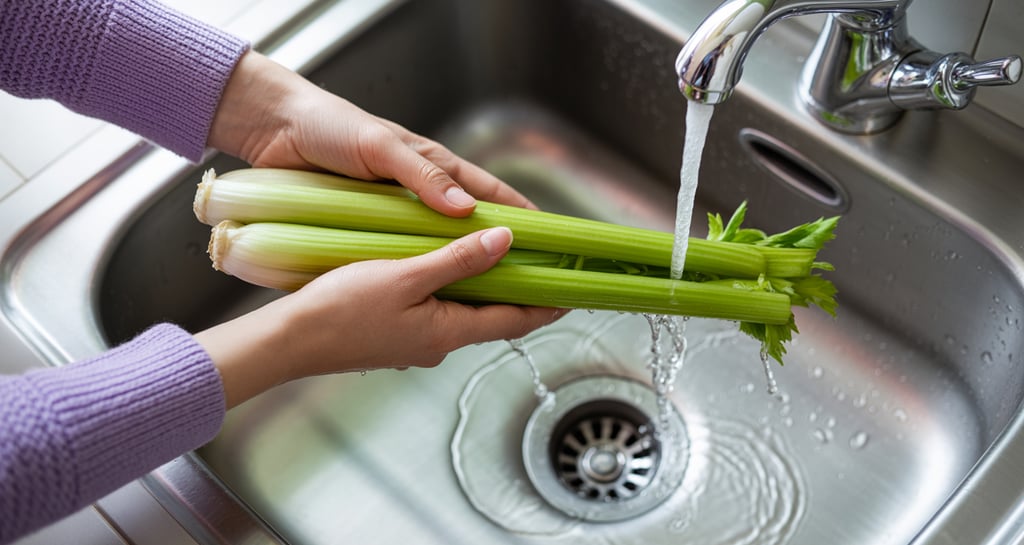How to Wash Fruits and Vegetables: A Complete Guide
Washing your fruits and vegetables might seem like a basic task, but it plays a crucial role in keeping your kitchen safe and your meals healthy. Every apple, lettuce leaf, or bunch of grapes you bring home has likely been handled by dozens of people and exposed to dirt, bacteria, and even pesticides during its journey from farm to store. You can't always see these contaminants—but they’re there. While fresh produce is packed with nutrients your body needs, consuming it without proper cleaning can lead to unnecessary health risks. In recent years, especially since the COVID-19 pandemic, people have become more conscious of food hygiene—yet confusion still exists about the right way to wash produce. This guide will clear that up by walking you through simple, science-backed methods to clean your fruits and vegetables safely, effectively, and without harsh chemicals.
5/2/20253 min read


Why You Should Always Wash Fresh Produce
Even if your fruits and veggies look clean or come pre-packaged, they're not automatically safe to eat. Here’s why washing is essential:
Multiple hands have touched them. From the farm to your fridge, produce passes through harvesting, transport, storage, and display - each step involves contact with people or surfaces.
They’re exposed in stores and markets. Produce is often coughed on, sneezed on, or handled by other shoppers.
Pesticide or fertilizer residues may linger. Even organic produce isn’t immune to natural residues from soil or compost.
Bacteria can live on the surface. Harmful germs like E. coli, Listeria, or Salmonella may be present on unwashed produce.
Bottom line: Proper washing can significantly reduce surface contaminants, giving you peace of mind every time you eat fresh food.
The Best (and Safest) Methods for Washing Produce
You may have heard advice encouraging people to use vinegar, lemon juice, baking soda, or even soap or bleach to clean produce more effectively.
❌ Don’t do it.
Food safety experts (including the FDA and CDC) strongly discourage using any chemicals or cleaning agents that aren't food-grade or proven safe. These can leave harmful residues, damage the food, or even cause health issues if ingested.
What Works Best?
Plain, cool running water and gentle friction are the most recommended, proven, and safe methods.
How to Wash Fruits and Vegetables Properly (By Type)
Different types of produce need slightly different washing techniques. Here’s a quick breakdown:
1. Firm Produce
Includes: Apples, pears, potatoes, carrots, cucumbers, lemons, etc.
How to wash:
Rinse under cold running water.
Use a clean produce brush to gently scrub the surface.
Dry with a clean paper towel or kitchen towel.
Why: These items often have pores or waxy skins that trap residues.
2. Leafy Greens
Includes: Lettuce, spinach, kale, Swiss chard, leeks, bok choy, Brussels sprouts.
How to wash:
Remove outer leaves or layers.
Fill a large bowl with cool water and soak the greens.
Swish them around gently to loosen dirt.
Drain and rinse under running water.
Use a salad spinner or pat dry with a clean towel.
Pro tip: For extra dirty greens, repeat the soak twice.
3. Delicate Produce
Includes: Berries, grapes, mushrooms, tomatoes.
How to wash:
Place in a colander.
Rinse gently under a low-pressure stream of water.
Use your fingers to rub gently and remove dirt.
Lay them on a clean towel and pat or roll dry carefully.
Note: Wash just before eating to prevent spoilage—these spoil faster when moist.
4. Produce with Peels
Includes: Oranges, avocados, melons, bananas.
How to wash:
Rinse and scrub the surface under water before peeling or cutting.
Dry before slicing.
Why: Bacteria on the outside can transfer to the inside via your knife.
5. Root Vegetables
Includes: Potatoes, turnips, radishes, beets.
How to wash:
Scrub under running water with a brush.
Peel if needed, but still wash first!
Mistakes to Avoid
Washing too early: Moisture encourages bacteria. Only wash right before you plan to eat or cook.
Using dish soap or bleach: These are toxic and not meant for food.
Not washing “pre-washed” greens again: Only skip washing if the label says “pre-washed” or “ready to eat.”
Skipping fruits you plan to peel: Bacteria on the outside can transfer to the flesh during peeling.
Quick Tips for Safe Produce Washing
Wash your hands first. Scrub with warm soapy water for 20 seconds before handling food.
Clean your surfaces. Wash your sink, cutting boards, and utensils regularly.
Use separate brushes or towels. Don’t cross-contaminate between produce and raw meat.
Dry produce well. Bacteria thrive in moisture - use a clean towel or spinner to reduce it.
What About Natural Washes or Vinegar?
Many people try homemade or natural cleaning solutions, like vinegar, lemon juice, or baking soda baths. While these may remove more pesticide residue in some cases, research shows they are not significantly more effective than plain water and gentle rubbing. Plus, they may leave unwanted flavors or residue behind.
If you do want to try them, baking soda (1 tsp per 2 cups water) is the most promising - but rinsing thoroughly with water afterward is still essential.
Washing fruits and vegetables properly is a simple but powerful step in your kitchen routine. You don’t need fancy products or chemicals - just water, your hands, and a little care.
Here’s the bottom line:
Always wash fresh produce before eating, even if it looks clean.
Don’t use soap, bleach, or chemical cleaners.
Wash right before eating - not when storing.
Use the correct method depending on the texture of the food.
Dry with a clean towel or spinner to prevent bacterial growth.
Keeping your food clean doesn’t need to be complicated - just consistent. With these safe practices, you’ll enjoy fresher, safer, and healthier meals every day.
Join us on Pinterest
letstalk@lorybs.com
© 2025. All rights reserved.
